Experience Divine Harmony: Gyalwa Gyamtso Mandala in Buddhist Practice
Red Chenrezig, also known as Gyalwa Gyamtso, is a deep embodiment of Tibetan Buddhism, representing the combination of knowledge and compassion. The depiction of Avalokiteshvara, the Bodhisattva of Compassion, and his consort is a potent spiritual paradigm combining enlightened attributes with material life.
Key Takeaways
- Gyalwa Gyamtso represents a profound expression of compassion and wisdom in the union.
- This deity figure is crucial in Vajrayana practices, emphasizing the integration of the spiritual and the mundane.
- Iconography and rituals associated with Gyalwa Gyamtso are rich in symbolism and offer unique insights into Buddhist teachings.
Gyalwa Gyamtso is a distinctive and significant deity in the pantheon of Tibetan Buddhist deities. His portrayal of Red Chenrezig in union with a consort exemplifies the tantric idea of the interdependence of knowledge (prajna) and compassion (karuna), two essential elements of the enlightenment path.
Origins of Gyalwa Gyamtso

The roots of Gyalwa Gyamtso can be found in early Tibetan Buddhism, where particular deity forms evolved due to the blending of native beliefs with Buddhist precepts.
Avalokiteshvara is a Buddhist figure that originated in Tibet and experienced significant alteration. This transition led to the birth of many forms, including Gyalwa Gyamtso. The Mahayana branch of Buddhism stresses the Bodhisattva ideal.
The Spread through Tibetan Lineages
The practice of Gyalwa Gyamtso has been acknowledged and spread by several Tibetan lineages, each of which has added ritual practice and interpretation levels. The Kagyu and Gelug schools lead these, where the god is worshipped as a guardian, enlightenment guide, and a symbol of compassion.
Several important tantric scriptures mention Gyalwa Gyamtso and thoroughly explain his attributes, symbolism, and rites. These writings function as fundamental scriptures for individuals who perform the devotions connected to this god.
Significance of Gyalwa Gyamsto Thangka
In Tibetan Buddhism, the Gyalwa Gyamsto Thangka is extremely important because it represents the pinnacle of enlightenment, knowledge, and compassion.
- Representation of Compassion
Chenrezig, often referred to as the Bodhisattva of Compassion, is the embodiment of the Buddhas' unending love and compassion. The deity's vivid red hue represents the warmth and depth of Chenrezig's compassion, directed toward every sentient being without exception.
Practitioners are motivated to develop compassion in their own lives when interacting with the thangka because it serves as a reminder of the global compassion present in the enlightened mind.
- Union of Wisdom and Compassion
One of the main ideas of Tibetan Buddhism is the composition of wisdom and compassion, represented by the Thangka painting of Chenrezig with his consort Palden Lhamo. The companion, frequently seen with Chenrezig, represents the supplementary facet of enlightened action, bolstering and augmenting the Bodhisattva's philanthropic efforts.
By highlighting the interdependence of compassion and wisdom on the path to enlightenment, this union pushes practitioners toward a well-rounded and comprehensive approach to spiritual practice.
- Meditation and Contemplation Aid
The thangka provides practitioners with a visual depiction of enlightened attributes and guiding principles, making it a powerful tool for meditation and introspection.
Practices that build virtues like compassion, loving-kindness, and altruism—all necessary for advancement on the spiritual path—focus their concentration on Chenrezig and his spouse.
The thangka's elaborate features and symbolic meanings give practitioners a framework for comprehending and applying Tibetan Buddhism's teachings to everyday life.
- Inspiration and Devotion
Practitioners get inspiration and respect from the Gyalwa Gyamsto Thangka, displayed at monasteries, temples, and personal altars. Practitioners' connection to the enlightened realm is strengthened, and devotion is inspired by the dazzling presence of Chenrezig and his spouse.
As a result of their sincere devotion and thoughtful reflection on the thangka, practitioners develop a close spiritual bond with Chenrezig, finding inspiration in his selfless example and blessings for their spiritual path.
Central Deity: Gyalwa Gyatso (Red Chenrezig) with Consort
- Attributes: Gyalwa Gyatso is shown with his consort in a passionate embrace, displaying four arms to represent the omnipotence and reach of compassion. Usually, the consort -Vajravarahi (symbolized by the first set of hands) is embraced by symbolic objects, signifying the union of consort wisdom with Chenrezig's loving conduct.
- Significance: This portrayal is crucial to understanding the Mahayana concept that wisdom and compassion are interdependent and necessary for enlightenment. This prominent location emphasizes that developing compassion is essential to enlightenment and is at the core of Buddhist practice.
Directional Deities: Manifestations of Avalokiteshvara
Akshobhya Avalokiteshvara (East)
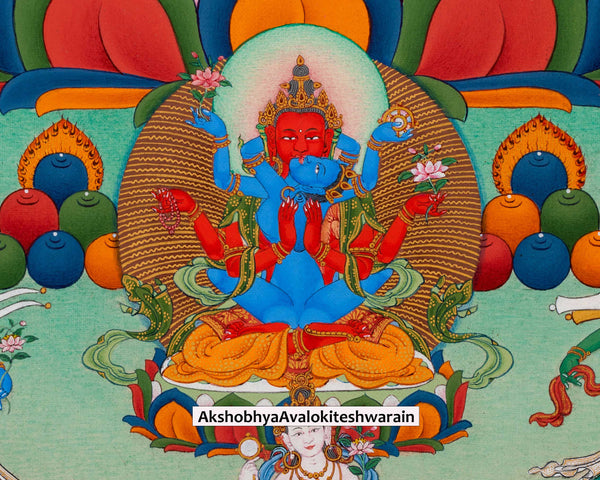
- Attributes: The red-clad Akshobhya-Avalokiteshvara is shown clutching a crimson lotus and a wheel in one hand. His blue partner represents the unfathomable profundity of the Dharma's teachings.
- Significance: In Buddhist cosmology, the element of fire, which can purify and change, is historically linked to the south. Akshobhya's appearance here represents the conversion of wrath into a clear, peaceful, and wise condition that resembles a mirror. His partner bearing a wheel symbolizes the dedication to implementing the Dharma's teachings in daily life.
- Consort Attributes: Blue, a hue that connotes calm and depth, represents his consort. In her right hand, she is holding a wheel representing the spinning of the Dharma wheel and sharing Buddhist teachings. A crimson lotus, a symbol of purity emerging from the muck of material life, is held in her left hand. This imagery shows her support of Avalokiteshvara's teachings and spiritual path.
Ratnasambhava Avalokiteshvara (South)

- Characteristics: Ratnasambhava is seen holding his consort, who is holding a crimson lotus, which symbolizes purity and enlightenment, and a gem, which represents wealth. His use of crimson highlights the enthusiasm and intensity of his philanthropic endeavors.
- Significance: Ratnasambhava represents the richness of one's experience via the practice of giving and generosity. He is positioned in the west, which is related in many Eastern traditions to the sinking sun and, hence, the completion or fulfillment of the day. The gem symbolizes the genuine richness of spiritual enlightenment.
- Consort Attributes: In Tibetan art, yellow is frequently connected to fertility, riches, and the earth element. The diamond she is clutching in her right hand symbolizes the giving of blessings and the accomplishment of all aspirations in the enlightened state. The crimson lotus on her left hand connects her even more to enlightened action and purity.
Amitabha Avalokiteshvara (West)
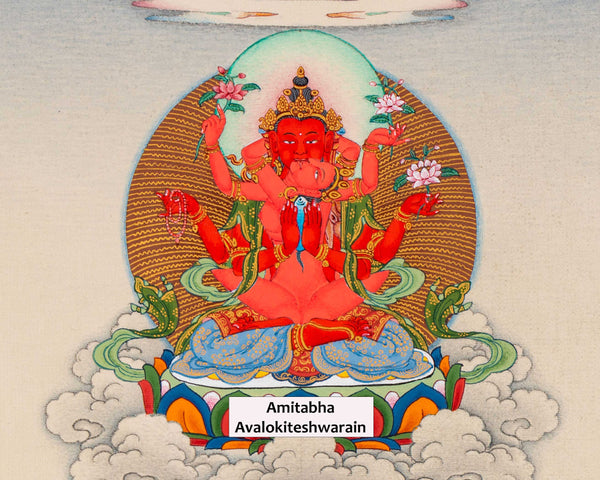
- Attritbutes: Amitabha Avalokiteshvara is shown as sitting in a contemplative position and emitting a friendly, warm light that stands for wisdom and compassion. In one hand he holds a lotus, indicating enlightenment and purity, while in the other he hold rosary beads while embracing his consort.
- Significance: Amitabha Avalokiteshvara is positioned in the west and represents the setting sun, signifying the passage from day to night and from this world to the world of enlightenment. Amitabha, the meaning of his name, is "Infinite Light," implying the brightness of wisdom that chases away the darkness of ignorance. As the main Buddha of the Pure Land school, he stands for the desire for reincarnation in his Western Paradise, where people can become enlightened quickly.
- Consort Pandavarisini: Consort Pandavarisini represents knowledge and compassion. Her presence is a symbol of the interdependence of compassion and knowledge, two attributes that are necessary for achieving freedom. Adherents are motivated to cultivate inner serenity and charity toward all living things by Pandavarisini's tranquil appearance and elegant stance.
Amoghasiddhi Avalokiteshvara (North)
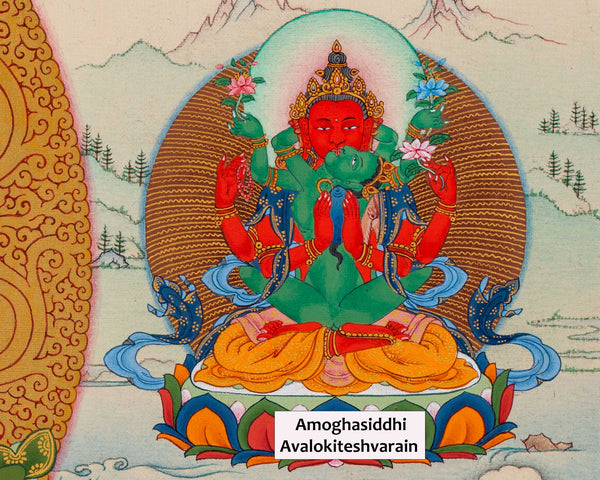
- Characteristics: Depicted with a consort clutching an uncommon blue lotus, or Utpala, signifying the triumph of the soul over the senses. Being red, the color of active compassion and resolve is Amoghasiddhi himself.
- Significance: Amoghasiddhi here is perfect for representing overcoming challenges and the need for a fresh start to advance spiritually. His job is to transmute envy into all-accomplishing wisdom so that deeds free from selfish ambitions might be taken.
- Green Samayatara, the consort, represents achievement and activity with her green hue. With understanding, she overcomes challenges with a blue lotus, or Utpala, in her right hand and a red lotus in her left, connecting her to the continuous activity of compassion.
Dakinis Representing Directions:
Vajradakini (South-East)
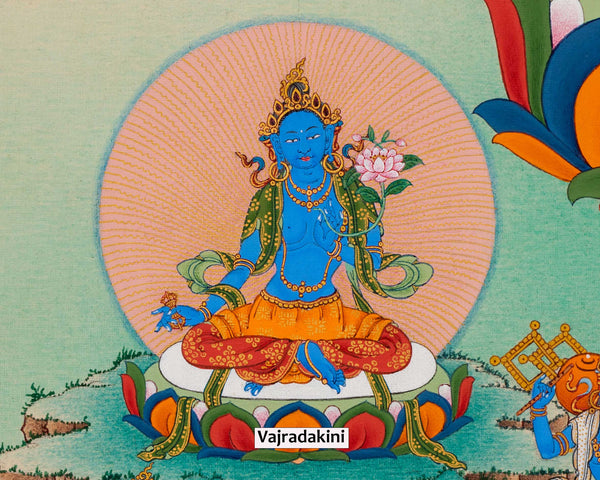
- Features: Vajradakini's blue hue represents depth and boundless expanse, much like the sky. The vajra she is holding represents the unbreakable nature of enlightenment and truth.
- Significance: This Dakini, oriented toward the southeast, discusses the physical components of spiritual practice and the body's metamorphosis. It implies that a strong interaction with the physical and spiritual realms is necessary for enlightenment.
Ratnadakini (South-West)

- Features: Her golden hue and the diamonds she holds symbolize prosperity, plenty, and the rich soil of the practice-cultivated mind.
- Significance: The diamonds and southwest orientation represent the abundance of spiritual development opportunities and the richness derived from a practice based on transparency and charity.
Padmadakini (North-West)

- Features: Red denotes her affinity for the heart, passion, and dedication, while the vase stands for holding and protecting the nectar of knowledge and compassion.
- Significance: Her placement towards the northwestdenotes a path towards spiritual profundity and understanding, where the practitioner's aspirations are converted into enlightened inspiration.
Karmadakini (North-East)
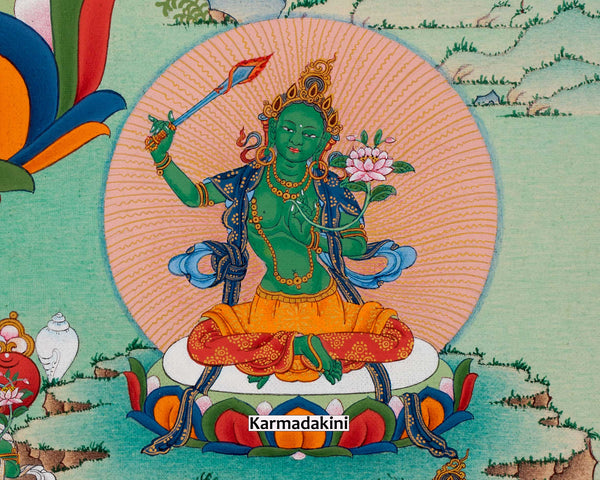
- Features: The color green symbolizes energy and movement. With her sword, she must strike through ignorance to make the path to enlightenment plain.
- Significance: The northeast direction, linked to energy and initiation, emphasizes firm, caring action to achieve spiritual objectives. With a keen understanding, this direction may cut through illusions.
Dakinis of the Five Senses:

- Rupavajra: This symbol represents the sense of sight. With a mirror in her right hand, she can see the outside world and understand the nature of reality. The lotus in her left hand represents the ability to perceive the purity in everything.
- Sabdavajra: Captures the sound feeling. She holds a flute in her right hand, signifying the value of listening and how sound may convey spiritual lessons. The lotus in her left hand represents the teachings' purity.
- Gandovajra: The third is Gandovajra, which is connected to scent. In her right hand, she holds an incense holder used in rituals to cleanse the area and create a favorable atmosphere for meditation. The lotus symbolizes the spiritual practice's transcending quality.
- Rasavajra: This symbol stands for taste. In her right hand, she holds a food holder, symbolizing the sweetness of enlightenment and the sustenance offered by the Dharma. The lotus in her left palm emphasizes how fulfilling spiritual development may be.
- Sparsavajra: This one is related to touch perception. She gestures to the tactile encounters with the outside world and the need to understand the physical world spiritually while holding garments in her right hand. The lotus in her left hand alludes to the ability to retain purity even when interacting with the physical world
Purpose and Usage of The Thangka
Several facets of Tibetan Buddhism make use of the Gyalwa Gyasto Mandala. They work as centers of attention for meditation, enabling practitioners to see themselves inside the mandala and develop a strong connection with the enlightened entities and attributes shown there.
Furthermore, as reminders of the journey to waking, thangkas are frequently depicted as objects of veneration and inspiration in monasteries, temples, and individual altars.
Placement of Different Deities and Consorts
The deities are carefully positioned inside the mandala to elicit symbolic meanings and encourage introspection. The arrangement of each god inside the mandala symbolizes the interaction of these attributes in the practitioner's spiritual path.
Each deity represents certain traits and elements of enlightenment. Consorts standing next to the main god represent the marriage of compassion and knowledge, highlighting how these essential facets of enlightenment are inextricably linked.
Meaning Behind Consorts and their Divine Union
In Tibetan Buddhist iconography, consorts are essential because they represent the complementary side of enlightened activity. They symbolize the merger of compassion (feminine) and knowledge (male), encapsulating the peaceful assimilation of dualistic ideas into a cohesive whole.
The consort's presence beside the main god represents the interdependence of compassion and wisdom on the road to enlightenment, pointing practitioners toward a well-rounded and comprehensive style of spiritual practice.
With their unique characteristics and symbolic meanings, each of these deities is essential to the thangka's overall depiction of the Buddhist universe.
Together, their iconography and the sensory sensations they symbolize highlight many facets of the route to enlightenment, providing a holistic picture of the spiritual journey. In addition to being a stunning artwork of Red Chenrezig, the thangka also functions as a tool for meditation and a symbolic road map for achieving ultimate emancipation and spiritual insight.

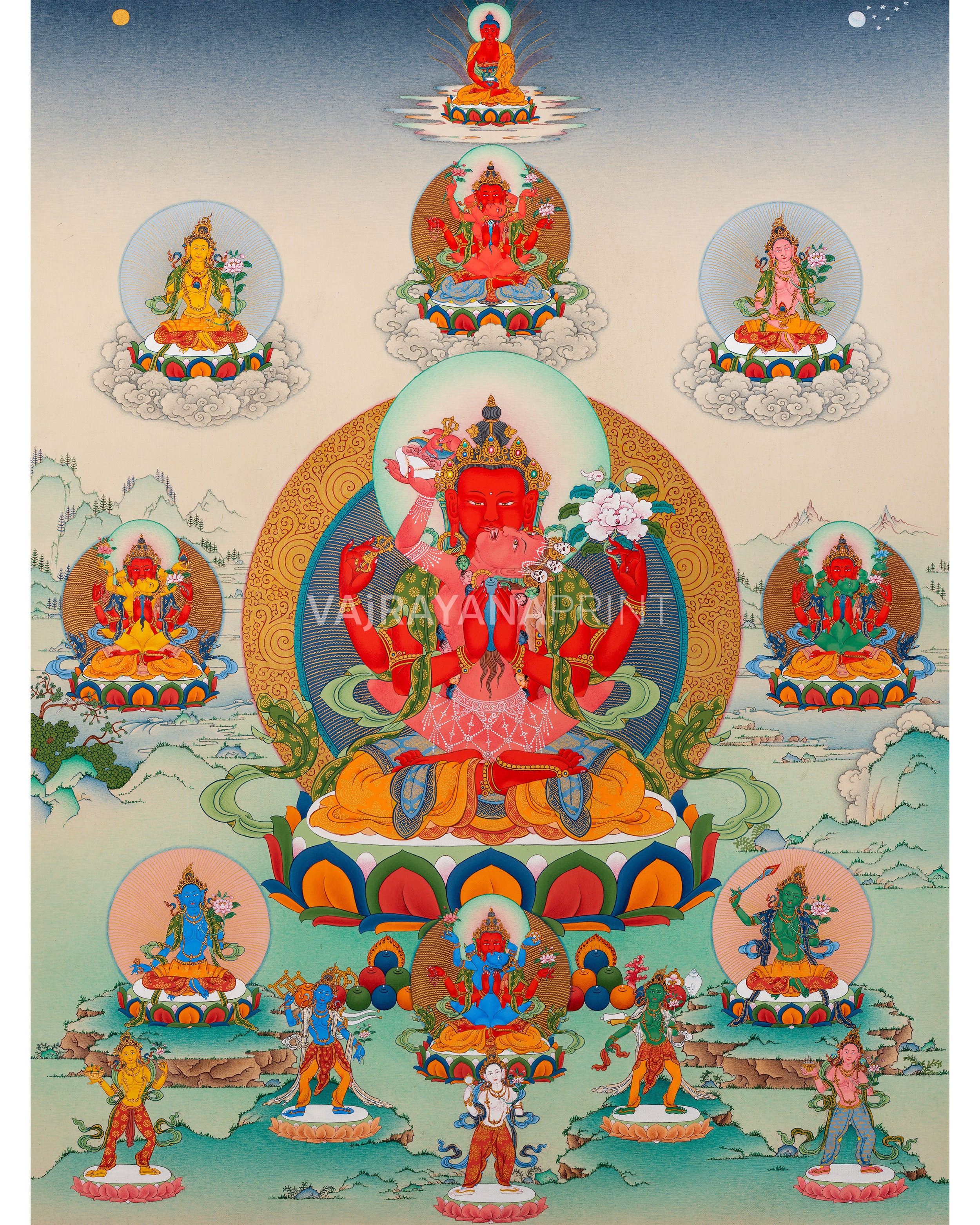
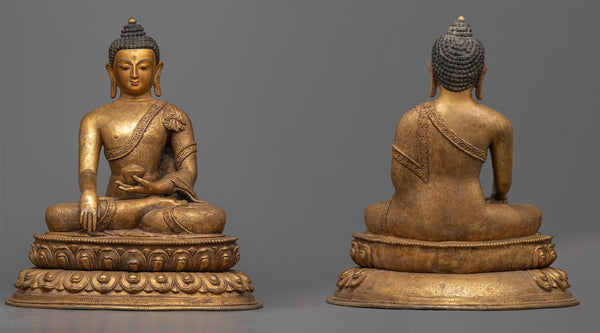
1 comment
Leonardo Garcia
Inspirador, é ensinamento do dharma! Lindo demais!